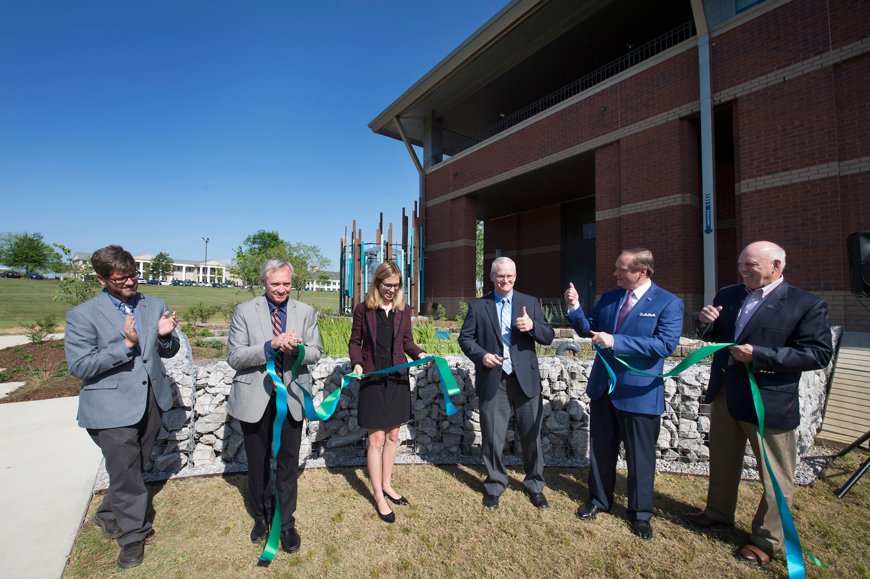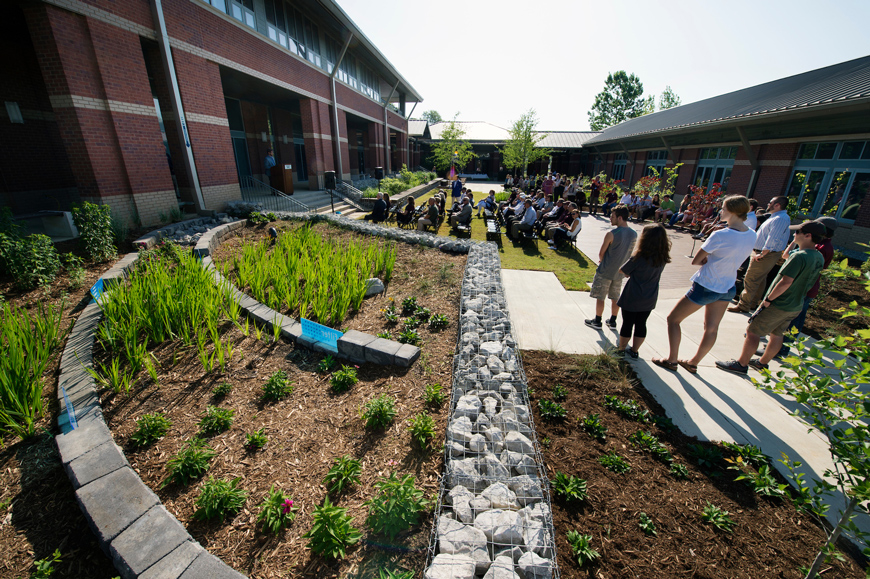EPA raingarden ribbon cutting marks observation of Earth Day at MSU
Contact: Vanessa Beeson

STARKVILLE, Miss.—Mississippi State faculty and students are celebrating the realization of a dream four years in the making.
Three cross-college departments commemorated a new raingarden at the university with a ribbon cutting Friday [April 21] in observation of Earth Day. The raingarden is located in the courtyard of the Landscape Architecture Facility on the Starkville campus.
Landscape architecture students in the College of Agriculture and Life Sciences built the garden, funded by a $20,000 U.S. Environmental Protection Agency grant to create a green infrastructure training and demonstration project. Those also contributing to the project include graphic design and engineering students, as well as the MSU facilities management department.
Mississippi State University President Mark E. Keenum spoke about the importance of sustainability at the ceremony.

“I am so pleased to see so many students who took an active role in leading this effort to make a difference. Having a wonderful raingarden to demonstrate the sustainability of water is something we are all going to learn from for years to come,” Keenum said. “Our university must address critical challenges like this for the future and instill in our younger generations knowledge of how to develop innovative solutions.”
Cory Gallo, associate professor in the Department of Landscape Architecture, said the raingarden manages one-fourth of the building’s rainwater runoff, but the project’s main purpose is to serve as an educational showpiece that teaches students, faculty and the broader community about green infrastructure technologies.
“The focus of this is really about education. This is the most comprehensive raingarden demonstration project in Mississippi and perhaps even in the Southeast. I don’t know of any that communicate what a raingarden does as well as this one,” Gallo said.
The raingarden’s focal piece is a 2,000 gallon cistern that collects rainwater and directs excess water into a 1,500-square-foot bioretention basin where it is managed with soil and plants. The raingarden is a sustainable water management demonstration in three steps -- conveyance, storage and management. As water comes off the roof, it goes into the cistern for storage and then into the garden. Once in the garden, the water is cooled, filtered, absorbed and delayed.
Gallo explained the effects of the process.
“If you come here a day or two after it rains, you’ll hear water making its way into the basin because that’s how much water flow has been slowed down. When there is less water, it becomes much slower and takes more time, and it’s cleaner and cooler as it comes through. It’s an audible experience,” he said.
In previous semesters, landscape architecture students installed the basin in addition to surrounding benches. Part of that previous work included collaboration with the Department of Civil and Environmental Engineering in the Bagley College of Engineering. Civil engineering students completed water quality testing prior to construction as part of the preliminary work.
“This is one of the most amazing projects where landscape architects, graphic designers and civil engineers worked together marching toward environmental sustainability. It is a win-win situation for all involved,” said Veera Gnaneswar Gude, assistant professor in the Department of Civil and Environment Engineering.
Graphic design students from the College of Architecture, Art and Design also worked alongside landscape architecture students to develop informational graphics to communicate the project’s purpose in an effective, concise manner.
Both landscape architecture and graphic design students enrolled in a cross-college collaborative course were tasked with designing, creating and installing the cistern; building out the garden; and developing, creating and implementing the demonstration component.
Suzanne Powney, assistant professor in the Department of Art, discussed how that hands-on collaboration, especially the opportunity for graphic design students to assist in the construction of the garden, resulted in a better design. She said while the work was challenging at times, the students took it in stride and did an incredible job.
“All of the students worked really hard. I am very proud of them,” she said. “This is a permanent structure they can come back to years in the future and say, ‘I built this.’”
In addition to Friday’s ribbon cutting, students also participated in a ceremonial first planting in the new MSU Community Garden immediately adjacent to the raingarden.
For more information, visit MSU’s Department of Landscape Architecture online at lalc.msstate.edu; the College of Architecture, Art and Design at caad.msstate.edu; and the Bagley College of Engineering at bagley.msstate.edu. The Water Resources Research Institute, housed at Mississippi State, facilitated the raingarden project’s grant and budget.
MSU is Mississippi’s leading university, available online at www.msstate.edu.